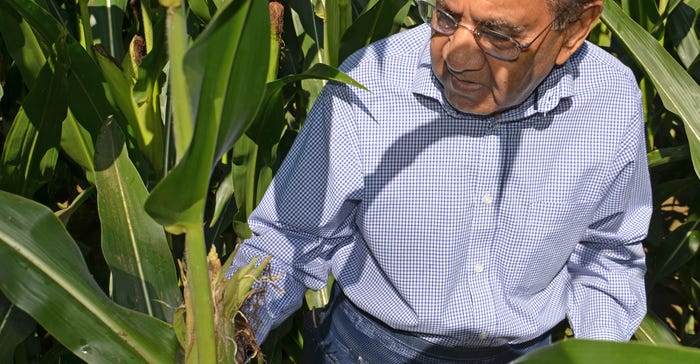
When you evaluate corn hybrids in a company test plot or on your own farm, what are you looking for? After the season, you look at yield. But what characteristics should you be looking at in the field?
“Hybrids have many different characteristics that you can determine in the field,” says Dave Nanda, director of genetics for Seed Genetics Direct. Nanda is also a plant breeder.
“Final yield is very important, but you also need hybrids with other favorable characteristics,” he says. “Plus, it helps to know which characteristics distinguish one hybrid from another.”
Nanda recently pointed out a number of differences between two hybrids planted side by side in the Farm Progress Corn Watch ’20 plot, a project sponsored by Seed Genetics Direct.
Here are nine characteristics that helped Nanda distinguish between the two hybrids:
1. Plant height. There was an obvious difference in overall plant height between the hybrids. It was evident once they tasseled out and reached their final height. Nanda looks for hybrid height to become shorter in the future, as breeders turn out genetics that yield well at high populations. However, today, there are still taller hybrids that yield well.
2. Tassel structure. The architecture of the tassel, which sheds pollen, varies by hybrid. Often, there is a difference in the number of branches per tassel. In this case, one hybrid had eight branches on each tassel; the other had nine or more on each tassel.
3. Maturity. Once ears form, you can determine maturity based on progression of the milk line within kernels. In this case, one hybrid was maturing a few days ahead of the other.
4. Leaf count. The taller hybrid with ears slightly behind on maturity had 18 to 19 leaves per plant. The slightly earlier-maturing hybrid had 16 to 17 leaves per plant. “I was involved in helping establish many years ago that there is a correlation between maturity and number of leaves,” Nanda says. “Earlier-maturing hybrids tend to have fewer leaves.”
5. Ear placement. There was at least a 6-inch difference in height of ear placement above the ground between the hybrids, Nanda notes. Ears on the shorter hybrid were placed slightly lower on the plant.
6. Rows of kernels and ear length. Genetics primarily determines number of rows of kernels per ear. Environmental factors and weather stress can also impact row number. In this case, the later-maturing hybrid tended to have 18 rows per ear, and the earlier hybrid 16 rows. Ear length is also somewhat determined by genetics and impacted by weather conditions.
7. Kernel depth. Here is where the rubber meets the road for yield. Kernels on the earlier-maturing hybrid appeared deeper, but the cob diameter was also larger. Conditions during grain fill have a large impact on final kernel size.
8. Roots and brace roots. Without digging plants up, you can often see differences in roots. In this case, one hybrid had more aggressive brace roots on the surface than the other hybrid.
9. Disease tolerance and resistance. You could start the list with this crucial trait, if you prefer, Nanda says. Gray leaf spot was intense on lower leaves when Nanda inspected this field, particularly on the earlier hybrid. “It was on both hybrids, but was more intense on one than the other,” Nanda says. “You need to ask about tolerance to various diseases.”
To see photos of these differences, click through the slideshow.
About the Author(s)
You May Also Like




